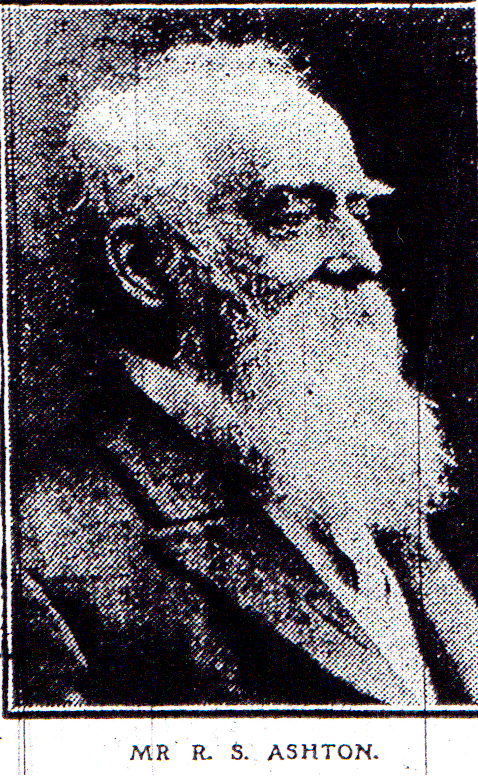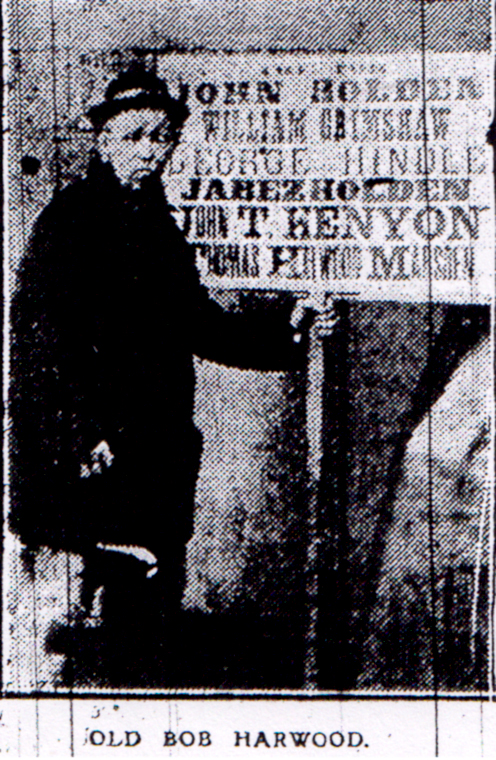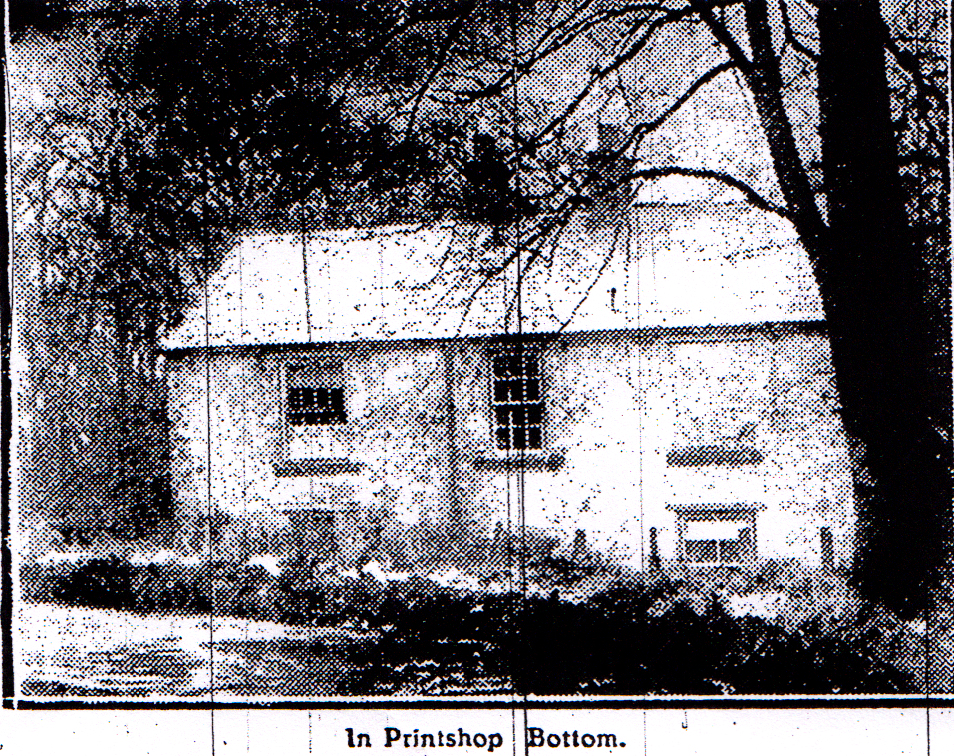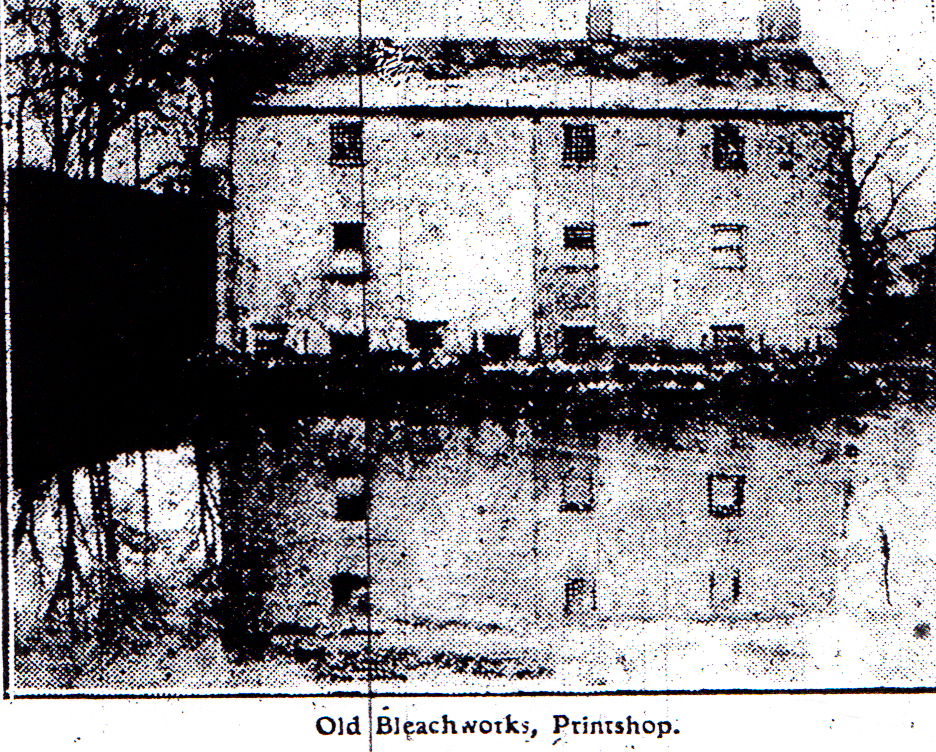Bits Of Old Darwen
The Town In Other Days
From the Blackburn
Weekly Telegraph January 17th 1914
There was a Time when cherry trees yielded crops of fruit on
the north-east side of Bowling Green Mill—by some claimed to be the first
power-loom mill in Darwen—and when the gardens now a part of Low Hill, between
the mill and Bury Fold Lane, were all green fields. These times are yet fresh,
though so far distant, in the memories of the few real old Darweners who
survive. Amongst those who never forget the Darwen that was is Mr. Ralph
Shorrock Ashton, whose review, going back to the days of his youth—he is now
83—is crowded with happy recollections of Darwen and its people. Mr Ashton now
lives in London, he has been away for many years.
Woodlands, where William Huntington lived later on, and now the residence of
Mr. George Yates was built by Mr. Ashton’s father, who came to Darwen in the
[eighteen] thirties, and so did Mr. Eccles Shorrock. Mr. Ashton’s father
married for his second wife a Miss Shorrock of Prince’s. Ralph Shorrock Ashton
laboured for a high standard of life and was connected with the establishment
of the old Mechanic’s Institute, to which so many now prominent Daren men admit
they owe the foundation of their careers. And he served his district for a term
as chairman of the old Local Board. The picture I am able to publish of old Bob
Harwood carrying an electioneering board is an interesting reminder of the
fights there were for seats upon the Board. Connections of Mr. Ashton’s
stepmother’s family were influential at the beginning of the dead (sic)
century, when Darwen was no more than a wayside hamlet, separated from outside
districts by the difficulties of traveling. They saw it awaken to its
possibilities, and in no small degree assisted to develop its energies in many
directions. Calico printing and bleaching had been introduced as profitable
industries four and forty years before the days of Mr Ralph Shorrock Ashton’s
boyhood began. Old James Greenway had added them to the industries of
coal-getting and hand-loom weaving. Mr Ashton was born early enough to see
power-loom weaving in its infancy at Darwen, though he was not living at its
birth. Four years before he saw the light of revolutionary power-looms set up
at Bowling Green Mill, popularly known as “Top Factory,” had been smashed by
indignant hand-loom weavers, who feared that the innovation meant starvation
for themselves, and they also similarly treated the loom of Mr. James Grime. In
the evening of Mr. Ashton’s long and eventful life many incidents and stories
of the Darwen of by-gone days recur to him, and some of these I have been
fortunate enough to obtain from him, and am permitted to include in this series
of articles.
 Darwen is not the Darwen it was when Mr. Ashton was a boy. Gone are the
well-grown trees from the Anchor to Dove Cottage, and houses and other
buildings now stand where they were rooted. The approach to Bowling green Mill
from Sandhills had trees on either side of the road, but these have
disappeared. The workers at the mill who lived in Bury Fold came by a footpath
turning out of the lane at a spot close to Low Hill, and through the fields.
The Holmes, Stoney Flatts and the land northward of Darwen Mills were not built
upon, and neither was the Lea. Nicholas Holden’s farm near Woodside Mill was in
the country. Shorey Bank was a country residence and its gardens full of fruit
trees. Behind were grazing fields, sloping down on which flocks grazed,
encircled by a rivulet which came down from Marsh House. The fields stretched
away to Sudell Road and Trinity Church.
Darwen is not the Darwen it was when Mr. Ashton was a boy. Gone are the
well-grown trees from the Anchor to Dove Cottage, and houses and other
buildings now stand where they were rooted. The approach to Bowling green Mill
from Sandhills had trees on either side of the road, but these have
disappeared. The workers at the mill who lived in Bury Fold came by a footpath
turning out of the lane at a spot close to Low Hill, and through the fields.
The Holmes, Stoney Flatts and the land northward of Darwen Mills were not built
upon, and neither was the Lea. Nicholas Holden’s farm near Woodside Mill was in
the country. Shorey Bank was a country residence and its gardens full of fruit
trees. Behind were grazing fields, sloping down on which flocks grazed,
encircled by a rivulet which came down from Marsh House. The fields stretched
away to Sudell Road and Trinity Church.
“Hand-loom weaving was common in my early days.” Mr Aston says. “The farmers on
the hillsides added little to their incomes by weaving in sheds adjoining their
houses. And the occupation was not confined to farmers. As a boy I was much
interested in the scenes at Prince’s in the days of old Mr. Shorrock, who gave
out yarn, cops and warps to the weavers around to be woven into cloth, which he
afterwards sent to Manchester for sale. It was at Prince’s that the father of
the late Christopher Shorrock was born.
“Social conditions have greatly changed since the [eighteen] thirties. An
average workman who earned 12s a week considered himself well off; masons got
from 3s to 3s 6d a day, labourers 2s and quarrymen 2s to 2s 6d, colliers 12s to
15s a week. Hours in the factory were long, from 3.30 in the morning to 7.30 at
night, and on Saturdays till 4 in the afternoon. During the winter months
colliers never saw the light of day except on Sunday. Food was dear, foreign
corn was then kept out to help the landlords, and the principal food was
oatmeal porridge and buttermilk. Coal was cheap. Good housefire coal could be
brought at 7s 6d a ton and steam at 5s a ton.
“Mrs Shaw—a worthy old lady—lived at the Bowling Green Inn. Soldiers were
quartered upon her during the plug-drawing riots of [18]26 and some of them
went away without paying though she said they `reckoned fair.‘
“I remember with interest the paper-works at Darwen Mills established and
worked by Messrs. Hilton, and supplied with coal from the Dogshaw mines at the
top of Darwen Moors. The coal was brought down by a railway running under
Bolton Road up past Radfield, and onto the moor. The trams consisted of eight
waggons. Four laden with coal drew up the four empty ones. There is a matter of
interest connected with the mines. Those called the 20-inch mines were mostly
worked in Darwen, Entwistle and Hoddlesdon.
“My early recollections carry me back to an old pit behind Darwen Mills, long
since unused as having been worked out. The 20-inch mine supplied good coal, as
did the many other mines spread about the valley. The pit behind the mill was
about 80 to 100yards deep, I think, but below that mine lies a rich mine about
70 yards lower. This was called the yard mine, but it was not considered
profitable to sink down so low owing to the water, which would have to be
pumped up at great expense. At Dogshaw on the Moor, 1,400ft. high, I think,
which was worked by the railway I have mentioned, there were two mines—the 20in
mine and the yard mines—almost on the same level. How came they then in
contrast with the mines 70 to 80 yards below Darwen Mills? The explanation is
that there is what in geology is known as a fault running along the road
leading from Bolton to Darwen, and this marked a great volcanic upheaval in
past days. The mines were thrown up on high, and not only so, but they must
have had special upheaval to have been thrown up almost to the same level as
the 20in mine. The coal from the yard mine was splendid. How glad the people of
Darwen would be if now they could enjoy the same supply of coal as that which
prevailed even during the [18]50’s, when it was laid down at the people’s doors
at 7s 6d per ton, and steam coal obtained at 5s a ton.
“At the beginning of the 19th century Darwen was traversed by two
high roads from north to south. The best of these followed the ridge of the
hill on the east side from Eccleshill and over Blacksnape, and was part of the
ancient road from Blackburn to Bury and Manchester. The other, a packhorse
road, narrow, crooked, circuitous, and ill kept was from Chapels down from
robin Bank, across the River Darwen by the ford where Union Street Bridge is
now. When in flood the river was impassable, and had power and depth sufficient
to carry down a horse and rider, as in the case of Mrs. Bowden in 1804. The
track continued passing behind Smalley’s Hotel, now Gregg’s Hotel, down the
Green up Bridge street, where there was a second ford of the river up Redearth
Road, on to Sough, twisting back again by Watery Lane and the present site of
Culvert School, and south-wards over the fields to Cadshaw Bridge and Bolton.
It was the main road between Blackburn and Bolton, and there were frequent
trains of packhorses bringing commodities and supplies.
 “Squire Greenway was the only man who could live on his means without the
necessity of trade or profession. Two others might lay claim to honour. These
were old Lawrence Burry, Of Kebb’s and another well-known Character of the days
of my boyhood whose chief employment was to take their children’s meals to the
mills, stand at the corner and pick up gossip. The father of squire Greenway
was a shrewd man, and made his money as a calico printer at Dob Meadows. In
those days pieces that were bleached and printed would be put out in the fields
on rails to get the chemical effect of the air or to dry. Thefts were committed
in the night, and the watchman was given a gun and set to keep sharp outlook.
One Morning he met Mr. Greenway with a long face and said `Heigh Mester
Greenway, they’n been and ta’en my blunderbuss.` the man was promptly
dismissed. Mr Greenway was always dressed plainly, and one day coming to his
counting house he was accosted by a traveller who did not known him, and asked
him to hold his horse. He did so, and the traveller went inside to transact
business. On returning he gave Mr. Greenway half a crow. The old gentleman went
inside and asked who the traveller was? On being told he said, `Give him no
more orders. If he can afford to give me half a crown for holding his horse a
quarter of an hour or so, depend upon it he is getting to much out of me in
extra charges.
“Squire Greenway was the only man who could live on his means without the
necessity of trade or profession. Two others might lay claim to honour. These
were old Lawrence Burry, Of Kebb’s and another well-known Character of the days
of my boyhood whose chief employment was to take their children’s meals to the
mills, stand at the corner and pick up gossip. The father of squire Greenway
was a shrewd man, and made his money as a calico printer at Dob Meadows. In
those days pieces that were bleached and printed would be put out in the fields
on rails to get the chemical effect of the air or to dry. Thefts were committed
in the night, and the watchman was given a gun and set to keep sharp outlook.
One Morning he met Mr. Greenway with a long face and said `Heigh Mester
Greenway, they’n been and ta’en my blunderbuss.` the man was promptly
dismissed. Mr Greenway was always dressed plainly, and one day coming to his
counting house he was accosted by a traveller who did not known him, and asked
him to hold his horse. He did so, and the traveller went inside to transact
business. On returning he gave Mr. Greenway half a crow. The old gentleman went
inside and asked who the traveller was? On being told he said, `Give him no
more orders. If he can afford to give me half a crown for holding his horse a
quarter of an hour or so, depend upon it he is getting to much out of me in
extra charges.
“Mr Hoghton Ainsworth, who ran the loom-shed called Springfield Mill in Bolton
Road, was a stern old Puritan, and claimed to be something of a theologian. His
dress was a black tail-coat, such as gentlemen use nowadays for evening dress.
And he wore white stockings and low shoes. Mr. Eccles Shorrock senior, was the
first to adopt morning dress. A young swell at Blackpool would were white
trousers, white stockings, and brilliant patent leather pumps. His shirt front
would be elaborately got up with frills that had been put through a goffering
machine. And his hat would be a fine beaver.
“My first school was a mixed school for boys and girls kept by an old lady of
the name of Mrs. Entwistle. She lived first in a house just opposite Ebenezer
Capel, and next in Union Street when New Mill was being built. I can remember
the fireproof arches over the boilers falling in and killing a poor man whom we
saw carried out on a stretcher.
One of my school-fellows was Miss Pickup, a daughter of William Pickup, of
Marsh House. She was somewhat older than I, and very kind in helping me to do
my multiplication tables. My next school was that of Mrs Ianson and her
daughter, who kept a school in a house at the corner of Bentley’s woodyard,
which was then opposite the present Co-operative Stores. The woodyard was the
playground of the school-children. The Openshaw’ and the Cunliffes were also at
the school.
“Mrs Ianson was postmistress, and I have seen her and her daughter examining
the letters very carefully, taking them up and holding them to the light. This
was done not because she was prying into people’s secrets, but because those
were the days of dear postage, and it was her duty to examine letters and see
if they had any enclosures. If any were found the postage charge was doubled.
Letters were charged for according to the distance carried. The charge for 300
miles for a single sheet was one shilling. Double sheets were treated as two
letters. It was owing to the double charge that the postmistress examined the
letters.
“It is a matter of interest to know that in 1831 a meeting was held at Darwen
in support of the great Reform Bill. The speakers were Mr. Harry Hilton, the
Rev. S.A. Nicholas (of Lower Chapel) Mr. Eccles Shorrock, the Rev. L.A. Hague
(of the old Ebenezer Chapel) and Mr. William Hutchingson. Mr. Richard Hilton’s
father, I think, of Mr. Henry and Mr. Edward Hilton, was in the chair. Mr.
Henry and Mr. Edward worked the paper mill in my young days. In 1832 Darwen,
then a small place, paid more duties to Government than its larger neighbour Blackburn.
This was owing to the heavy duty on paper which was levied at the paper works
before the paper was allowed to be taken away.
“The Rev. S.T. Porter of the old Ebenezer Chapel and of Belgrave Independent
Meeting House was the mainspring of the establishment of the mechanics
Institution in 1839, and I can see him now in a long dressing gown in a room
devoted to the infant institution.
“Every woman had a chance of getting married if she wanted to in the [18]30’s,
for the census showed that there were 3,421 males and 3,551 females in the town
, and 1,202 families living in 1,252 houses. There were few `quality` folk, and
only 28 female servants.
“In Sough Village old James Pickup and William Shorrock lived, and they were
two careful bodies. `does ta’ know ‘at when tha’rt spending a ha’penny tha’rt
spending both capital and interest,` old James would say. Money was valued
because it was hard earned. A man once remarked, `What’s the use of working and
saving? Thoase ‘at come after will spend it.` `Aye Aye,` replied the one to
whom he spoke `an if they hev as much pleasure I’ th’ spending as I’ve hed I’
th’ saving of it they’re welcome.
“Funerals were made a lot of when I was a lad. At Bowling Green Mill there was
a joiner who was better of than many others and wore good broadcloth. He was
often asking off to go to funerals, and it was thought the reason was because
he was so well dressed and looked so respectable. He was regularly placed on
the front seat of the mourning coach.
“Bowling Green Mill taught Darwen how to spin, and gave work out to many of the
great-grandfathers and great-grandmothers of the present generation. When it
could not spin it made room for Robert Nightingale’s old curiosity shop of
domestic and literary stores. And old Robert has passed away, and his shop is
closed.”


The contemporaries of
Mr. Ashton were Mr. Greenway, uncle of the late Rev. Charles Greenway and known
as Squire Greenway and had considerable property, The Potters, the Hiltons, who
have a vault at Lower Darwen, The Brandwoods, who were colliery proprietors,
the Wardleys, the Walshes, Seth Harwood, the overseer, and the pickups amongst
others.
Mr Ashton recalls a good story of old Lower Chapel. He says that;
“the children upstairs were under the care of a teacher who would make a ball
of his pocket handkerchief and throw it at a boy or girl who was talkative or
restless< The late Alderman Christopher Shorrock was a boy who was sent by
his father to a special service at the chapel, and his father gave him the
money for the special collection. Chris sat in a great square pew one Sunday,
and when the collection time came he could not find the money. Every pocket was
searched. Marbles, nails, a penknife, and other things were turned out, but the
money could not be found. Nearer and nearer came the collection-box, and at
length it reached young Chris, whose face was by this time scarlet. The
collector was not to be done. `What hesta done wi’ t’ money?` He asked, `for I
know thy feyther wodn’t send tha beawt.` He put down his box in the pew, got
old of little Chris and turned his pockets out one by one until the money was
found.
“Another story of Lower Chapel is that in the days of the candle the
chapel-keeper would go round snuffing them with his fingers. Snuffers were at
length introduced, but he did not take kindly to the new-fangled things and
would go round with the snuffers in his left hand. The candel he would snuff
with the fingers of his right hand, and the burnt wick he would deposit in the
box of the snuffer.
“Darwen had no lawyers in the old days and we had to go to Blackburn for our
law. All the letters were brought by a postman on foot from Blackburn to
Darwen. It was not an uncommon thing for Mr Eccles Shorrock to send someone,
some times my brother, on horseback to meet old William, and old Waterloo
veteran, and get the Darwen post-bag from him.
“The progenitors of Pole Lane Chapel and Ebenezer were mostly farmers and
weavers, Nathaniel Hunt, the father of Jeremy, promised £50 to the building
fund of Pole Lane. Jeremy, in after days was an enthusiast, and after walking
all the way from Pickup Bank to the service at Ebenezer, would go without his
Sunday’s dinner in order to give the money to the chapel debt. Another, a young
woman, went without her summer gloves, and gave the money at the Sunday School
collections. I remember the service; the men in their drab coats, and the women
in their big bonnets, with shawls flowing over their simple dresses of brown,
blue or red merinos, and nearly all carrying an old-fashioned posy. Ebenezer
had a grand base fiddle, which as a child I regarded with awe; William Becket
played the fiddle and Jeremy Hunt led the singing.
back to top

